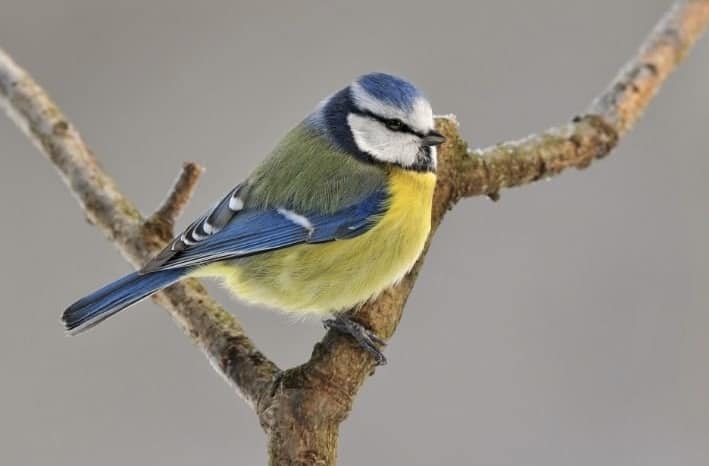Blue tits are one of the most common garden birds, and are known for being beautiful and characterful in equal measures.
So, what is the life cycle of a blue tit, and how long can you expect the same blue tit to visit you in your garden?
The typical blue tit lifespan is three years, however the oldest recorded blue tit in the UK was 10 years and three months old. Their many predators and threats mean that the chance of survival is small in the early stages of their life, and in subsequent years. The life cycle of a blue tit is vulnerable to sudden changes in weather, an impact to their food source and changes to their habitat.
Blue tits (or Cyanistes caeruleus) are a type of tit commonly found in gardens across the UK. They are recognisable by their blue wing, tail and crown, but have a number of other distinguishing features. Their chests are yellow, which is believed to be due to the high quantity of carotene pigments found in their diet, from eating caterpillars! Their back is a yellowish-green colour, their cheeks are white with a black outline, and their bill is black-brown.
With a wingspan of 18cm, blue tits are similar in size to other tits, especially coal tits. The average blue tit is 12cm in length, and typically weighs 10g – 11g. Male and female blue tits are generally the same size, but the male may have slightly more vibrant colouring than the female, especially under UV light. Young blue tits are more green-brown than blue, and their cheeks are yellow instead of white.
Blue tits are loyal, monogamous birds, meaning that per breeding season, one male with mate with one female. They mate for life so, unless one of the two dies, every breeding season the same two blue tits will mate. There are currently over 3.5 million breeding pairs of blue tits in the UK, making them one of the most common garden birds.
Female blue tits build their nests on their own, and in the spring time. These nests are cup-shaped structures made from tree back, leaves, dead grass and moss. Blue tits have been known to use the same nesting spot each year, which is usually situated in holes in tree trunks or in garden birdboxes.
The Life Cycle Of A Blue Tit
- Blue Tit Eggs
The eggs of a female blue tit are glossy and smooth. Each female will lay up to 13 eggs in one brood, although most of the time this number is closer to eight or nine eggs. The eggs are white with brown spots, and are incubated by the female for up to 15 days before they hatch. During the incubation period, her male partner will bring her food.
- Blue Tit Nestlings
Once the eggs have hatched, the baby blue tits are known as nestlings. Nestlings are primarily fed caterpillars by their parents, which is a source of the carotene pigments that give them their yellow chest. These nestlings will be fully dependent on their parents for 16 – 22 days, relying on them for both food and security.
- Blue Tit Fledglings
Once large and strong enough, nestling blue tits will transition into the next stage as a fledgling. This is the period of time in which blue tits will leave the nest, learning to fly and forage over a period of days or weeks. Despite the fact that they are one of the most common garden birds, the vast majority of blue tits, an estimated 62%, do not make it to one year old. Factors such as the weather, number of predators in the area and the territory of their parents can all impact a fledgling’s likelihood of survival.
- Juvenile & Adult Blue Tits
Young garden birds such as blue tits often stay close by to their parents for a number of months after flying the nest, occasionally relying on them for food. Once they reach adulthood, the annual survival rate of a blue tit is 53%.
Blue Tit Predators & Threats
- Predators
Blue tits and some of the other most common garden birds are often preyed upon from the sky and the ground. They are food for various different birds of prey, and domesticated animals on the ground. Jays, crows, owls and, most commonly, sparrowhawks (kestrels) are the deadliest predators of small birds such as blue tits.
In addition to being hunted from the sky, blue tits are commonly preyed upon by domestic cats and dogs, and sometimes foxes too. Their numerous predators means that a blue tit lifespan is unfortunately often short.
- Habitat Threats
Blue tits live in a wide range of habitats across the UK and the rest of Europe. They typically live in both deciduous and mixed woodland, gardens, parks, hedgerows and ditches. They don’t just stick to rural areas; they’re often found in towns and cities.
While some threats to their habitats are as a result of human interference, some are a result of other animals. Blue tit nests may be robbed by both grey and red squirrels, and even weasels, in the UK.
Read more about blue tit nesting habits, including how many broods there are throughout a blue tit lifespan, here.

